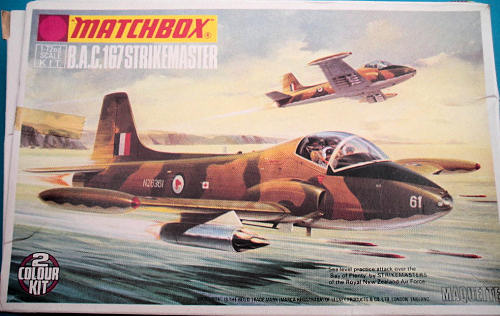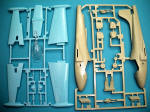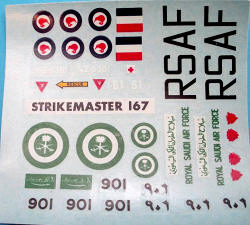
Matchbox 1/72 BAC 167 Strikemaster
| KIT #: | PK-10 |
| PRICE: | Currently out of production |
| DECALS: | Two options |
| REVIEWER: | Victor Scheuerman |
| NOTES: |

| HISTORY |
BAC’s Strikemaster was an aircraft that incorporating the rugged simplicity of the Jet Provost Mk.4, but was able to carry nearly 4 times the armament load over a wider radius of action. The B.A.C. 167 was used by a number of air forces as a close support ground attack machine and by the R.A.F. for pilot training. Two machine guns were fitted to the fuselage and 8 underwing attachment points provided for the carriage of bombs, rockets, fuel tanks etc. The side-by-side seating greatly assisted in training. (Thanks largely to the kit instruction sheet.)
| THE KIT |
 Matchbox’s
Strikemaster consist of a total of 27 molded parts including a one-piece
clear canopy. The surface is a combination of deeply engraved panel and
control hinge lines and raised panel lines and stiffeners on the rudder and
elevators. As one would expect, the cockpit is a simple affair with the two
ejection seat shapes molded together that hold two well-sculptured aircrew.
There is a partial aft bulkhead and an instrument that combined with the
seats and pilots, should help fill the large open cockpit. One of the good
points about modelling 1/72 scale jets today are the numerous after market
ejection seats. Nothing says ‘jet cockpit’ like the ejection seat!
Matchbox’s
Strikemaster consist of a total of 27 molded parts including a one-piece
clear canopy. The surface is a combination of deeply engraved panel and
control hinge lines and raised panel lines and stiffeners on the rudder and
elevators. As one would expect, the cockpit is a simple affair with the two
ejection seat shapes molded together that hold two well-sculptured aircrew.
There is a partial aft bulkhead and an instrument that combined with the
seats and pilots, should help fill the large open cockpit. One of the good
points about modelling 1/72 scale jets today are the numerous after market
ejection seats. Nothing says ‘jet cockpit’ like the ejection seat!
With the Strikemaster being a beefed up Jet Provost to offer a low cost attack aircraft, it is no surprise that some stores are included in the kit. But this was another area that Matchbox went simple on as stores are limited to just one set of vertical rack of rockets for each side. The landing gear members are well done with the one-piece nose gear/tire being worthy of mention. While the nose gear bay is framed in, it is rather shallow and the main gear bays are not framed in. All the gear doors need to be sanded thinner or replaced with card.

Final parts are the
two-piece intakes, one-piece horizontal tail and blade antenna for the upper
fuselage. Assembly of this quick build is covered in eight well illustrated
steps with detailed colour notes offered separately at the end. I feel
compelled to comment on the colour of the paper used. This is the first
Matchbox kit that used ‘mauve’ coloured paper!
Two decal options are offered and both are foreign operators in tactical camouflage. A Royal New Zealand Air Force example in Vietnam style and coloured camouflage is the first and this features only the national insignia, basic stencils and the serial number in white. A more colourful Strikemaster from the Royal Saudi Arabian Air Force is in desert colours along with patches of orange (day-glo?) on the fuselage and wings. This features the same basic markings but the fuselage titles are on a white back ground and offer some visual interest. The decals look fine and useable after all these years though a coat of Micro Liquid Decal Film might be a good idea.
| CONCLUSIONS |
Having built one of these several years ago for my son, it does go together well and fast; not bad attributes. However, the Airfix Strikemaster is a better kit.
If you would like your product reviewed fairly and quickly, please contact me or see other details in the Note to Contributors.